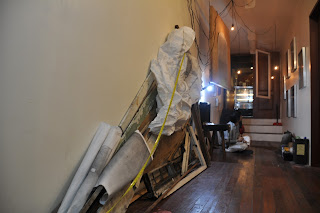Christopher Angelo Yñiguez tackles motion and transition in his current artworks. Anonymous birds in flight, migrating. Feet barely touching ground in that gesture after take-off. A gorge opening to a landscape. The view of a faraway horizon. The distance between here and there, measured. An open suitcase, suggesting either packing or unpacking. Windows as frames, the inches connecting the outer and inner spaces. A narrow rock passage leading to the sea. Perceptions of faces as seen by a newborn child, some details barely there and yet to become. The exhibit space of a corridor that links a bookshop, a restaurant, a hotel and a spa. The Tourist, experiencing the here-and-now between arrival and departure.
Extracting such themes from experience, he blurs borders between painting, illustration, sculpture and installation to create his art.
Born to Filipino parents who migrated to America in the 1970s, he spent most of his 28 years in the suburbs of Los Angeles. Expressions of alienation, emptiness and searching surfaced constantly in things around and within him.
“I was hungry for rootedness”, Christopher Yñiguez says of his past.
He filled this deficiency with diversity afforded by his multicultural environment, weaving around him friends of different colors. He studied Illustration in art school and worked as an archivist after. He dipped into varied art expressions, trying different flavors of creativity. Still finding himself struggling with the same alienation, emptiness and searching, he decided to relocate to the Philippines in July of 2009.
When asked what home is to him, he answers, “Home is nurturing. A place or state or situation that responds to you and where, in return, you put something back, you respond. There’s that mutual give and take. There’s flow.”
There’s also a mutual give and take involved in his artwork. Intending to engage the viewer of an art piece in dialogue, he points out that the audience has a role to respond to an art piece, as much as the artist has a role to move the viewer. His art pieces make the viewer more aware of how time and distance affects our visual experience, asserting that visual works of arts are more than just alterations of a space, more than just occupying a space. More aspects and details of his artwork reveal themselves according to how much distance and how much time one spends with it. The viewer takes a more active role than just opening their eyes.
The artist poses what he sees, with gestures that have thought, intention or impulse behind them. And the viewer takes part in the completion of the artwork, responding to the artwork with their own thoughts and feelings, in this case their own experiences of being lost, of searching, of motion, of flight, of transition, and ultimately, of being seen, of being found, of finding one’s self and one’s home. With his art, he aims not just in providing content and ideas but also catalyzing change and process within the person, containing emotions.
We could also be The Tourist finding ourselves, in one way or another, in motion and transition; life itself, for example, being transitory. We look at The Tourist and it mirrors us, we see us. And in yet another reconfigured point, The Tourist looking is being looked at.








